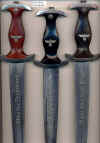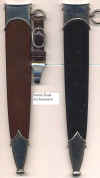|
SA/SS/NSKK Dagger Characteristics |
|
| This section has been composed by Bernie Brule of the SS Reference Web Site. Bernie specializes in SS research on artifacts and members of the SS. Full documentation of research found will be supplied upon completion of any project undertaken. | ||||||||||||||||||||||||||||||||||||||||||||||||||||||||
|
Characteristics of Third Reich SA/SS/NSKK Style Daggers It would be impossible to accurately describe Third Reich dagger construction practices and variations in one web page. However, the following table offers guidelines in recognizing the different dagger construction techniques and materials used on model 1933 SS/SA/NSKK daggers throughout the dagger production period from 1933 to approximately 1942. This doesn't mean that all daggers produced in each period will be made the same way or use the same materials. The change from one period to the other was gradual over time so that, for example, a dagger made at the end of 1935 or beginning of 1936 could exhibit characteristics of either or both periods. And there are exceptions to every rule - especially in collecting. Blatant omissions and errors can be pointed out to me but to tell me that a late production dagger could have a nickel-silver grip eagle is a waste of your time and mine. Having said this, I am always interested in hearing form people who have interesting anomalies to the table below. I apologize for the poor quality of the pictures below since I do not yet have a digital camera
SS Dagger Production Periods Side by side comparisons of dagger production periods (please allow enough time for it to load). From left to right: early, mid-period, late. The sharpness of the centre ridges are, unfortunately, not apparent in the scan. Most apparent are the difference between the nickel-silver (left and centre) and plated (right) crossguards and the nickel-silver (left and centre) and aluminum (right) grip eagles. SS Dagger MottosThis provides the collector with a side by side view of samples of a few dagger maker mottos. Except for the Himmler Honour dagger (2nd from right), all are placed at the same starting point from the shoulder of the blade. From left to right are:
Painted and Anodized Scabbards Comparison of painted and anodized scabbards side by side. The brown scabbard on the left is anodized with nickel-silver fittings. The black scabbard on the right is painted with nickel plated fittings. Anodizing is actually a blueing process where the scabbard was stained either black for SS or brown for SA. A coat of lacquer was then applied to protect the finish. Often, all or part of the lacquer is missing. When this happens, the lacquer covered parts will normally appear darker than the rest. What appear to be scratches on the brown scabbard is where the lacquer has been removed. Anodized scabbards were sometimes period painted since the anodized finish is not durable and is easily scratched. Approximating Date of Manufacture The presence of a logo, RZM code or both along with the materials used in edged weapon production can be used to determine the approximate date of manufacture. Although most companies only had one logo during the period of the Third Reich, some manufacturers such as the Carl Eickhorn company used 4 separate logos during the Third Reich allows us to date an Eickhorn piece fairly precisely. 1933 to 1936 Metals such as nickel and silver are used in most of the fittings and high quality steel is used to make the blades which were then hand polished to a high sheen. Insignia is hand fitted into handles which are then hand fitted to the blade and its fittings. Hand tooling is apparent in some metal fittings. Crossgraining from the polishing process is clearly visible on the blades as is the company logo. 1936 to 1938 By 1936, the logo on political blades is being replaced by the RZM code with the logo and RZM code sometimes both appearing on the blade. Blades also begin to appear that are void of any logo or RZM code. Manufacturers begin using aluminum and plated "pot metals" in the production of some fittings and scabbards. Plated blades also begin to appear. Hand finishing is no longer apparent in all aspects of production. 1939 to 1942 Logos on political blades have been completely replaced by the RZM code. High quality metals such as nickel and silver have been totally replaced by plated and sometimes non-plated "pot metals" as well as aluminum in the production of fittings and scabbards. Today, flaking and "old" rust may be present on plated parts. Hand finishing has disappeared and quality suffers as a result in the form of ill fitting handles and insignia. Blades are plated and those that aren't have a dull satin finish as opposed to a high sheen. Some late production pieces will even have a mixture of plated, aluminum and nickel parts as stores of parts are used up. All this combines to make the edged weapons produced in this time period often the most difficult to authenticate. |
||||||||||||||||||||||||||||||||||||||||||||||||||||||||



